Juanjuan Zhao
APBench: A Unified Benchmark for Availability Poisoning Attacks and Defenses
Aug 07, 2023



Abstract:The efficacy of availability poisoning, a method of poisoning data by injecting imperceptible perturbations to prevent its use in model training, has been a hot subject of investigation. Previous research suggested that it was difficult to effectively counteract such poisoning attacks. However, the introduction of various defense methods has challenged this notion. Due to the rapid progress in this field, the performance of different novel methods cannot be accurately validated due to variations in experimental setups. To further evaluate the attack and defense capabilities of these poisoning methods, we have developed a benchmark -- APBench for assessing the efficacy of adversarial poisoning. APBench consists of 9 state-of-the-art availability poisoning attacks, 8 defense algorithms, and 4 conventional data augmentation techniques. We also have set up experiments with varying different poisoning ratios, and evaluated the attacks on multiple datasets and their transferability across model architectures. We further conducted a comprehensive evaluation of 2 additional attacks specifically targeting unsupervised models. Our results reveal the glaring inadequacy of existing attacks in safeguarding individual privacy. APBench is open source and available to the deep learning community: https://github.com/lafeat/apbench.
Learning the Unlearnable: Adversarial Augmentations Suppress Unlearnable Example Attacks
Mar 27, 2023



Abstract:Unlearnable example attacks are data poisoning techniques that can be used to safeguard public data against unauthorized use for training deep learning models. These methods add stealthy perturbations to the original image, thereby making it difficult for deep learning models to learn from these training data effectively. Current research suggests that adversarial training can, to a certain degree, mitigate the impact of unlearnable example attacks, while common data augmentation methods are not effective against such poisons. Adversarial training, however, demands considerable computational resources and can result in non-trivial accuracy loss. In this paper, we introduce the UEraser method, which outperforms current defenses against different types of state-of-the-art unlearnable example attacks through a combination of effective data augmentation policies and loss-maximizing adversarial augmentations. In stark contrast to the current SOTA adversarial training methods, UEraser uses adversarial augmentations, which extends beyond the confines of $ \ell_p $ perturbation budget assumed by current unlearning attacks and defenses. It also helps to improve the model's generalization ability, thus protecting against accuracy loss. UEraser wipes out the unlearning effect with error-maximizing data augmentations, thus restoring trained model accuracies. Interestingly, UEraser-Lite, a fast variant without adversarial augmentations, is also highly effective in preserving clean accuracies. On challenging unlearnable CIFAR-10, CIFAR-100, SVHN, and ImageNet-subset datasets produced with various attacks, it achieves results that are comparable to those obtained during clean training. We also demonstrate its efficacy against possible adaptive attacks. Our code is open source and available to the deep learning community: https://github.com/lafeat/ueraser.
Multi-View TRGRU: Transformer based Spatiotemporal Model for Short-Term Metro Origin-Destination Matrix Prediction
Aug 16, 2021



Abstract:Accurate prediction of short-term OD Matrix (i.e. the distribution of passenger flows from various origins to destinations) is a crucial task in metro systems. It is highly challenging due to the constantly changing nature of many impacting factors and the real-time de- layed data collection problem. Recently, some deep learning-based models have been proposed for OD Matrix forecasting in ride- hailing and high way traffic scenarios. However, these models can not sufficiently capture the complex spatiotemporal correlation between stations in metro networks due to their different prior knowledge and contextual settings. In this paper we propose a hy- brid framework Multi-view TRGRU to address OD metro matrix prediction. In particular, it uses three modules to model three flow change patterns: recent trend, daily trend, weekly trend. In each module, a multi-view representation based on embedding for each station is constructed and fed into a transformer based gated re- current structure so as to capture the dynamic spatial dependency in OD flows of different stations by a global self-attention mecha- nism. Extensive experiments on three large-scale, real-world metro datasets demonstrate the superiority of our Multi-view TRGRU over other competitors.
Incorporating Reachability Knowledge into a Multi-Spatial Graph Convolution Based Seq2Seq Model for Traffic Forecasting
Jul 04, 2021
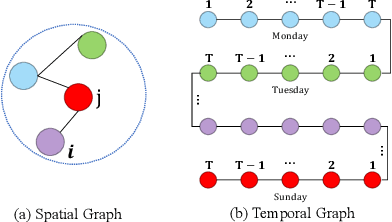


Abstract:Accurate traffic state prediction is the foundation of transportation control and guidance. It is very challenging due to the complex spatiotemporal dependencies in traffic data. Existing works cannot perform well for multi-step traffic prediction that involves long future time period. The spatiotemporal information dilution becomes serve when the time gap between input step and predicted step is large, especially when traffic data is not sufficient or noisy. To address this issue, we propose a multi-spatial graph convolution based Seq2Seq model. Our main novelties are three aspects: (1) We enrich the spatiotemporal information of model inputs by fusing multi-view features (time, location and traffic states) (2) We build multiple kinds of spatial correlations based on both prior knowledge and data-driven knowledge to improve model performance especially in insufficient or noisy data cases. (3) A spatiotemporal attention mechanism based on reachability knowledge is novelly designed to produce high-level features fed into decoder of Seq2Seq directly to ease information dilution. Our model is evaluated on two real world traffic datasets and achieves better performance than other competitors.
How to Build a Graph-Based Deep Learning Architecture in Traffic Domain: A Survey
Jun 07, 2020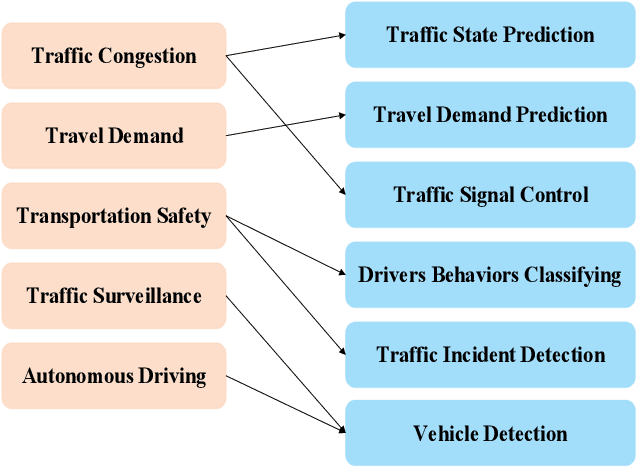
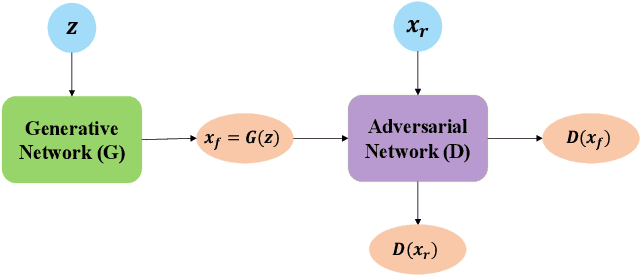
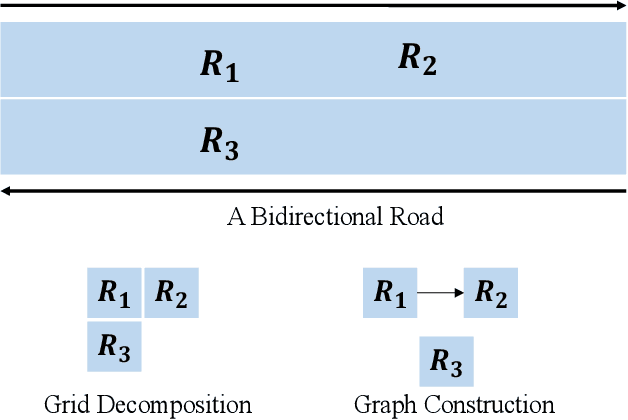
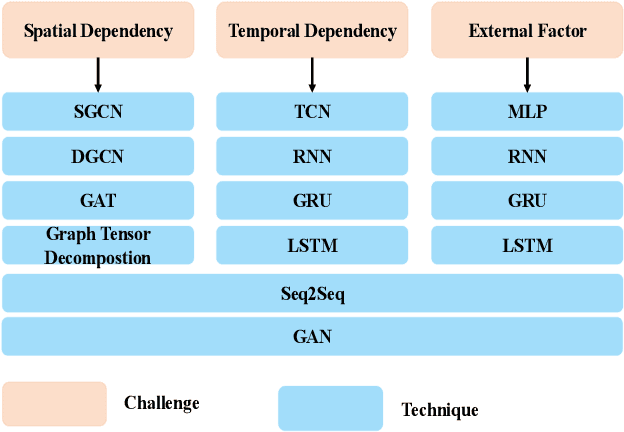
Abstract:In recent years, various deep learning architectures have been proposed to solve complex challenges (e.g., spatial dependency, temporal dependency) in traffic domain, which have achieved satisfactory performance. These architectures are composed of multiple deep learning techniques in order to tackle various challenges in traffic data. Traditionally, convolution neural networks (CNNs) are utilized to model spatial dependency by decomposing the traffic network as grids. However, many traffic networks are graph-structured in nature. In order to utilize such spatial information fully, it's more appropriate to formulate traffic networks as graphs mathematically. Recently, various novel deep learning techniques have been developed to process graph data, called graph neural networks (GNNs). More and more works combine GNNs with other deep learning techniques to construct an architecture dealing with various challenges in a complex traffic task, where GNNs are responsible for extracting spatial correlations in traffic network. These graph-based architectures have achieved state-of-the-art performance. To provide a comprehensive and clear picture of such emerging trend, this survey carefully examines various graph-based deep learning architectures in many traffic applications. We first give guidelines to formulate a traffic problem based on graph and construct graphs from various traffic data. Then we decompose these graph-based architectures to discuss their shared deep learning techniques, clarifying the utilization of each technique in traffic tasks. What's more, we summarize common traffic challenges and the corresponding graph-based deep learning solutions to each challenge. Finally, we provide benchmark datasets, open source codes and future research directions in this rapidly growing field.
Multi-View Graph Convolutional Networks for Relationship-Driven Stock Prediction
May 11, 2020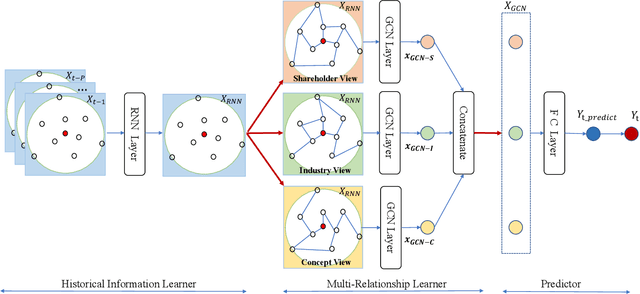

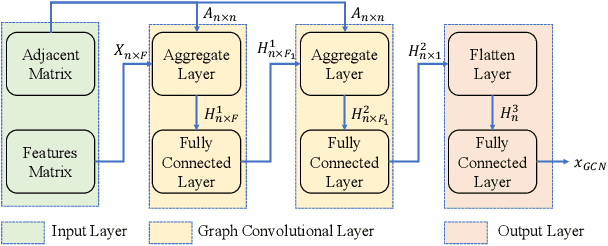
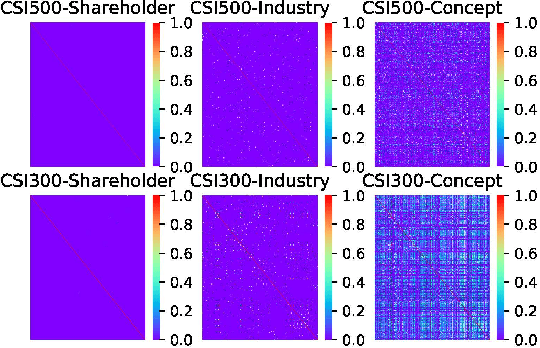
Abstract:Stock price movement prediction is commonly accepted as a very challenging task due to the extremely volatile nature of financial markets. Previous works typically focus on understanding the temporal dependency of stock price movement based on the history of individual stock movement, but they do not take the complex relationships among involved stocks into consideration. However it is well known that an individual stock price is correlated with prices of other stocks. To address that, we propose a deep learning-based framework, which utilizes recurrent neural network (RNN) and graph convolutional network (GCN) to predict stock movement. Specifically, we first use RNN to model the temporal dependency of each related stock' price movement based on their own information of the past time slices, then we employ GCN to model the influence from involved stock based on three novel graphs which represent the shareholder relationship, industry relationship and concept relationship among stocks based on investment decisions. Experiments on two stock indexes in China market show that our model outperforms other baselines. To our best knowledge, it is the first time to incorporate multi-relationships among involved stocks into a GCN based deep learning framework for predicting stock price movement.
Estimation of Passenger Route Choice Pattern Using Smart Card Data for Complex Metro Systems
Apr 19, 2016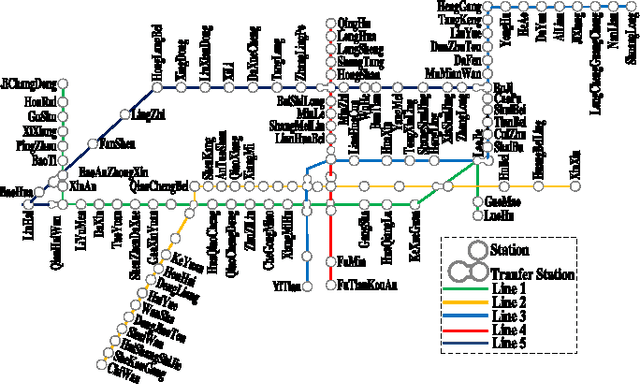

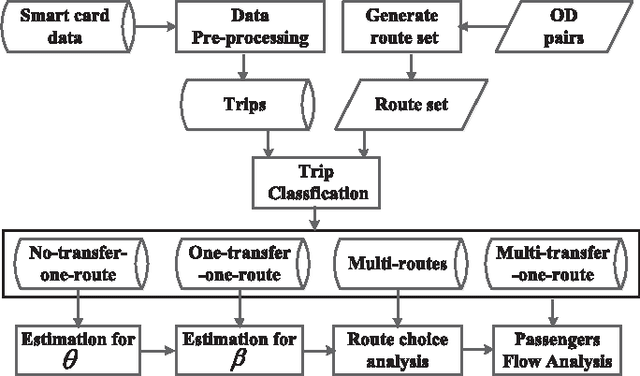
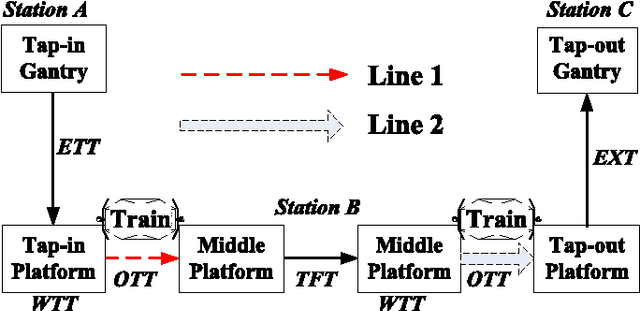
Abstract:Nowadays, metro systems play an important role in meeting the urban transportation demand in large cities. The understanding of passenger route choice is critical for public transit management. The wide deployment of Automated Fare Collection(AFC) systems opens up a new opportunity. However, only each trip's tap-in and tap-out timestamp and stations can be directly obtained from AFC system records; the train and route chosen by a passenger are unknown, which are necessary to solve our problem. While existing methods work well in some specific situations, they don't work for complicated situations. In this paper, we propose a solution that needs no additional equipment or human involvement than the AFC systems. We develop a probabilistic model that can estimate from empirical analysis how the passenger flows are dispatched to different routes and trains. We validate our approach using a large scale data set collected from the Shenzhen metro system. The measured results provide us with useful inputs when building the passenger path choice model.
 Add to Chrome
Add to Chrome Add to Firefox
Add to Firefox Add to Edge
Add to Edge